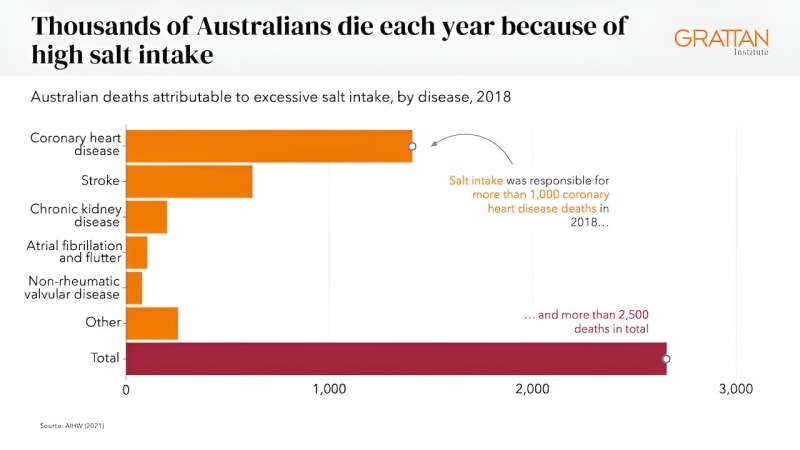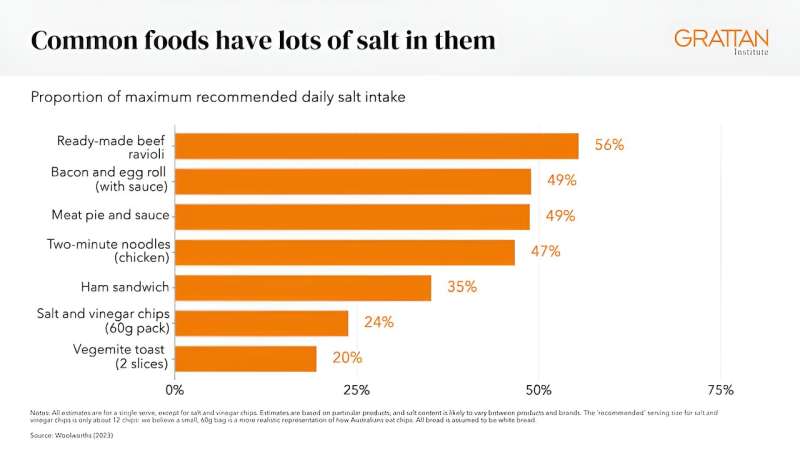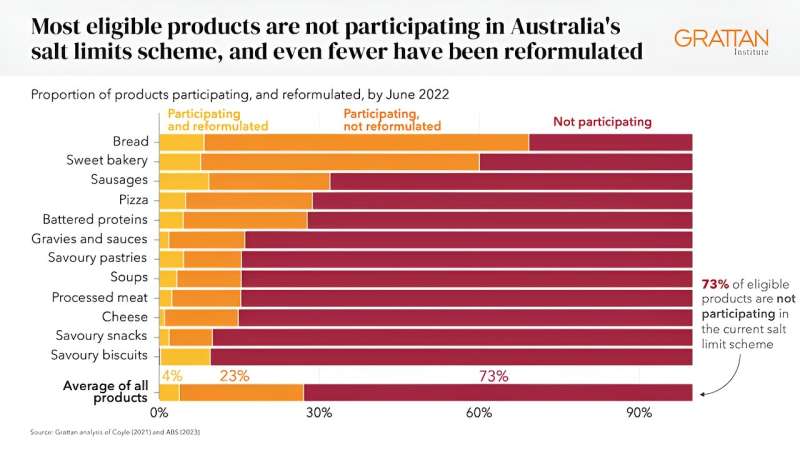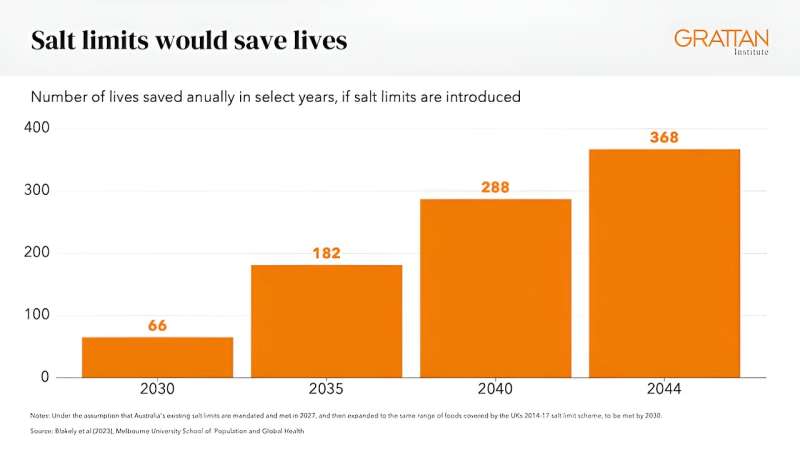This article has been reviewed according to Science X's editorial process and policies. Editors have highlighted the following attributes while ensuring the content's credibility:
fact-checked
trusted source
written by researcher(s)
proofread
Slashing salt can save lives—and it won't hurt your hip pocket or tastebuds

Each year, more than 2,500 Australians die from diseases linked to eating too much salt.
We shouldn't be putting up with so much unnecessary illness, mainly from heart disease and strokes, and so many deaths.
As a new Grattan Institute report shows, there are practical steps the federal government can take to save lives, reduce health spending and help the economy.
We eat too much salt, with deadly consequences
Eating too much salt is bad for your health. It raises blood pressure, which increases the risk of heart disease and stroke.
About one in three Australians has high blood pressure, and eating too much salt is the biggest individual contributor.
Unfortunately, the average Australian eats far too much salt—almost double the recommended daily maximum of 5 grams, equivalent to a teaspoon.
Australian governments know excessive salt intake is a big problem. That's why in 2021 they set a target to reduce salt intake by at least 30% by 2030.
It's an ambitious and worthy goal. But we're still eating too much salt and we don't have the policies to change that.
Most of the salt we eat is added to food during manufacturing

Most of the salt Australians eat doesn't come from the shaker on the table. About three-quarters of it is added to food during manufacturing.
This salt is hidden in everyday staples such as bread, cheese and processed meats. Common foods such as ready-to-eat pasta meals or a ham sandwich can have up to half our total recommended salt intake.
Salt limits are the best way to cut salt intake
Reducing the amount of salt added to food during manufacturing is the most effective way to reduce intake.
Salt limits can help us do that. They work by setting limits on how much salt can be added to different kinds of food, such as bread or biscuits. To meet these limits, companies need to change the recipes of their products, reducing the amount of salt.
Under salt limits, the United Kingdom reduced salt intake by 20% in about a decade. South Africa is making even faster gains. Salt limits are cheap and easy to implement, and can get results quickly.
Most consumers won't notice a change at the checkout. Companies will need to update their recipes, but even if all the costs of updating recipes were passed on to shoppers, we calculate that at most it would cost about 10 cents each week for the average household.
Nor will consumers notice much of a change at the dinner table. Most people don't notice when some salt is removed from common foods. There are many ways companies can make foods taste just as salty without adding as much salt.
For example, they can make salt crystals finer, or use potassium-enriched salt, which swaps some of the harmful sodium in salt for potassium. And because the change will be gradual, our tastebuds will adapt to less salty foods over time.

Australia's salt limits are failing
Australia has had voluntary salt limits since 2009, but they are badly designed, poorly implemented, and have reduced population salt intake by just 0.3%.
Because Australia's limits are voluntary, many food companies have chosen not to participate in the scheme. Our analysis shows that 73% of eligible food products are not participating, and only 4% have reduced their salt content.
Action could save lives
Modeling from the University of Melbourne shows that fixing our failed salt limits could add 36,000 extra healthy years of life, across the population, over the next 20 years.
This would delay more than 300 deaths each year and reduce health-care spending by A$35 million annually, the equivalent of 6,000 hospital visits.
International experience shows the costs of implementing such salt limits would be very low and far outweighed by the benefits.
How to fix our failed salt limits

To achieve these gains, the federal government should start by enforcing the limits we already have, by making compliance mandatory. Fifteen countries have mandatory salt limits, and 14 are planning to introduce them.
The number of foods covered by salt limits in Australia should more than double, to be as broad as those the UK set in 2014. Broader targets would include common foods for which Australia does not currently set targets, such as baked beans, butter, margarine and canned vegetables.
A loophole in the current scheme that lets companies leave out a fifth of their products should be closed. The federal government should design the policy, rather than doing it jointly with industry representatives.
Over the coming decades, Australia will need many new and improved policies to reduce diet-related disease. Reducing salt intake must be part of this agenda. For too long, Australia has let the food industry set the standard, with almost no progress against a major threat to our health.
Getting serious about salt would save lives, and it would more than pay for itself through reduced health-care costs and increased economic activity.
This article is republished from The Conversation under a Creative Commons license. Read the original article.![]()


















